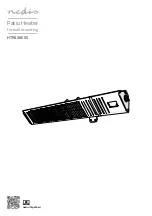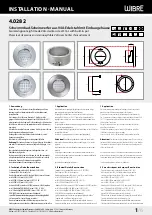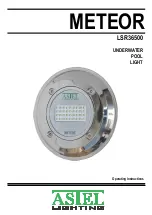
15
Rev. K 5-31-06
P/N 470880
Installation (contd.)
VENTILATION
The installation of venting system should conform with the
latest edition of ANSI Z223.1, the National Fuel Gas
Code, and/or in Canada, CAN/CGA-B149.1 or .2 or
applicable provision of the local codes.
INDOOR INSTALLATION
The pool heater is supplied with a draft hood. All
products of combustion and vent gases must be
completely removed to the outside atmosphere
through a vent pipe which is connected to the draft
hood. A vent pipe extension of the same size must
be connected to the draft hood and extended at least
2 feet higher than highest point of the roof within a
10 foot horizontal radius, and at least 3 feet higher
than the point at which it passes through the roof, or
as permitted by local code; see Figure 11. The vent
should terminate with an approved vent cap
(weather cap) for protection against rain or blockage
by snow. Double-wall vent pipe and an approved
roof jack shall be employed through the roof
penetration. The use of double-walled type B vent
pipe is recommended.
The draft hood must be installed so as to be in the same
atmospheric pressure zone as the combustion air inlet to
the pool heater. The certified (factory) draft hood
must
not
be modified in any way and must be employed in
every indoor installation.
The heater must be located as close as practical to a
chimney or gas vent. The heater should be installed
at least 5 feet away from the pool or spa.
The heater must be placed in a suitable room on a
non-combustible floor and in an area where leakage
from heat exchanger or water connections will not
result in damage to the area adjacent to the heater or
the structure. When such locations cannot be
avoided, it is recommended that a suitable drain pan
with adequate drainage, be installed under the heater.
The pan must not restrict air flow.
Installations in basements, garages, or underground
structures where flammable liquids may be stored
must have the heater elevated 18 inches from the
floor using a noncombustible base.
NOTE
The heater requires
two uninterrupted air
supply openings;
one for ventilation and one
to supply air for proper gas combustion; see
Figure 12.
Figure 11.
Table 5.
* Rise
Air Supply
Gas Combustion
Air Supply
Ventilation
Vent Cap and
Riser Furnished
by Installer
* 1” Rise Per Foot
Recommended
Minimum requirements for free air supply openings:
one 12 inches from the ceiling for ventilation and one
12 inches from the floor for combustion air as outlined
in the National Fuel Gas Code, ANSI Z223.1, or
Local Building Codes.
CAUTION
Chemicals should not be stored near the heater installa-
tion. Combustion air can be contaminated by corrosive
chemical fumes which can void the warranty.
NOTE
The heater requires
two uninterrupted air supply
openings;
one for ventilation and one to supply air
for proper gas combustion. The air supply openings
should be sized according to Table 5.
Air supply requirements below apply to all
MiniMax heaters, including PowerMax versions.
Figure 12.
Air Opening Requirements
{Net Free UNOBSTRUCTED Opening}
Air
Ventilation
Air For
Combustion
Model
525
288 sq. in.
288 sq. in.
750
432 sq. in.
432 sq. in.
900
576 sq. in.
576 sq. in.
















































